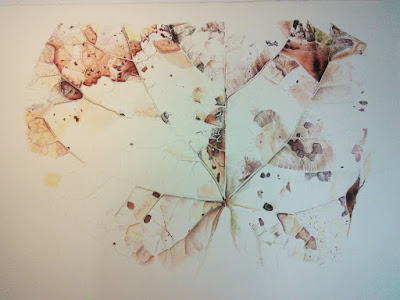Last night I dreamt I was painting molten magma... I remember getting rather flustered. This wasn't because I was standing on a hot volcano, but more because the stuff kept moving. It was very irritating. The movement was indeed slow, but nonetheless it moved and with my technique being of equal slow speed my paintings inevitably became very fluid in order to catch up with the rhythm. There is probably some Freudian symbolism going on, but the dream is more likely the product of 'much-intense-staring' at a decaying Judas Tree leaf... It's colours are amazing - more pink than yellow or orange and there are all these little black blemishes. I started this A1 painting on the 2nd of February and 8 days later we find ourselves here (below):
 |
| Judas Tree Leaf (10th February 2016) Work in progress on 76 x 56cm Saunders Waterford 640gsm paper |
It still isn't finished but I am very happy with the current painting pace. Unlike before where I used to paint for roughly 10 hours a day, I am now only clocking 7 hour working days (it's actually 9 but with two one hour breaks). This is obviously much healthier. I am able to do this because my pace is getting faster. This must be the result of practice and the fact that I am getting more rest by doing shorter days. I feel it is good to experiment with day length. I know for certain that I haven't found the optimum painting to break ratio, but I am getting close. Of course, this is a winter pace, come summer this mathematical sum will go flying out of the window as I adopt summer hours... There certainly is never a dull moment in the higher latitudes!
Colours...
This is a very unusual palette for me. I find focusing on yellows very, very difficult. Yesterday, however, something started to click and I am beginning to understand this part of the spectrum more. I am also understanding the importance of light washes and how to build layers. With this leaf, even in the same area, the colour of one layer of paint will be very different to another layer and the uppermost layers are often the 'brighter' colours, such as Permanent Rose and New Gamhodge. This is odd, as I always thought you should do it the other way around, adding the darker hues last so not to muddy the yellow. Oh well... For those who want to know, the colours I am using are:
W&N Olive Green (you'd be
surprised at how much - often an upper layer)
W&N New Gamhodge (bottom
and uppermost layers and in mixes. I have also only just worked this out
by looking at the bottom of the pan - I thought I was
using transparent yellow!)
W&N Permanent Rose
W&N Perylene Maroon (I
love this colour)
W&N Permanent Magenta (teeny
bit)
W&N Hookers Green (hardly
any)
DR Cobalt Blue (because
I love it. I am using this in mixes and in it's unadulterated raw form)
Brushes...
I am using loads of brushes for this one. I start with a biggy and go smaller as I work in the detail last. For the detail level I have a very slender rigger for the veins, a scruffy hard spotter for removing paint in the shadows to reveal veins and a big oil painting brush for scruffing/buffing the paper up (its ok - I burnish afterwards). I have three series 22 (Rosemary and Co) brushes, two at size 2 and one at size 3, one series 44 (size 2 or 3 can't remember). I think I might even have a series 441 in the mix too. So what's that? Eight brushes, yes that is about right. They are all on their last legs, so I am having to use loads for the job. Not ideal. Plus, with all the washes being of various colours, I have three of the series 22 on the go rather than just one to avoid wastage and contamination.
 |
| Close up on the right side... |
Over time...
I thought I'd put a little snapshot of this leaf day-by-day so you can see the progression - I haven't done this in a while. I used to do it all of the time!
 |
| Botanical illustration of a Judas Tree (Cercis siliquastrum) leaf (3rd February 2016) |
 |
| Botanical illustration of a Judas Tree (Cercis siliquastrum) leaf (4th February 2016) |
 |
| Botanical illustration of a Judas Tree (Cercis siliquastrum) leaf (5th February 2016) |
 |
| Botanical illustration of a Judas Tree (Cercis siliquastrum) leaf (6th February 2016) |
 |
| Botanical illustration of a Judas Tree (Cercis siliquastrum) leaf (7th February 2016) |
 |
| Botanical illustration of a Judas Tree (Cercis siliquastrum) leaf (8th February 2016) |
 |
| Botanical illustration of a Judas Tree (Cercis siliquastrum) leaf (9th February 2016) |

So fabulous! I wish I could see these all in real life, hopefully one day :) xxx
ReplyDeleteAmazing!!!
ReplyDeleteBRAVO! Really interesting the way of color. In my observation I found that color changes from the outside parts as the sap of the plant being less vital, doesn't reach the edges.
ReplyDelete